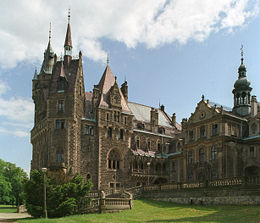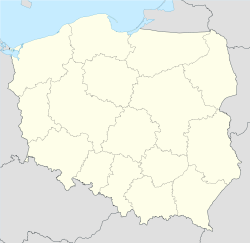- Moszna, Opole Voivodeship
-
See also: Moszna, Lublin Voivodeship
Moszna Castle in Moszna Coordinates: 50°26′N 17°46′E / 50.433°N 17.767°E Country  Poland
PolandVoivodeship Opole County Krapkowice Gmina Strzeleczki Time zone CET (UTC+1) – Summer (DST) CEST (UTC+2) Postal code 47-370 Area code(s) +48 77 Car plates OKR Moszna [ˈmɔʂna] (German: Moschen) is a small village in south-west Poland, approximately 30 km (19 mi) from Opole, known for its notable castle.
Contents
The village
In 1309 the area, which is nowadays occupied by Moszna, was settled by a family called Mosce or Moschin. In 1679 the village belonged to the family of von Skalls and it became the property of Wilhelm von Reisewitz around 1723. Later on, Moszna belonged to Heinrich Leopold von Seherr-Toss (since 1771); Heinrich von Erdmansdorf (1853); and to Hubert Tiele-Winckler (since 1866).[1]
A horse breeding farm was founded in Moszna in 1946. It was based on a herd from a liquidated farm in Dłonie, near Rawicz. The farm in Moszna has kept thoroughbred horses from the very beginning and it expanded its husbandry with cross-breeds in 1961.[1]
The castle
The castle in Moszna is one of the best known monuments in the western part of Upper Silesia. The history of this building begins in the half of the 17th century, although old cellars were found in the gardens during excavations which were carried out at the beginning of the 20th century. Some of the investigators, including H. Barthel, claimed that those cellars could have been remnants of a presumed Templar castle, but their theory has never been proved true. After World War II, further excavations discovered a medieval palisade.[1]
The central part of the castle is an old baroque palace which was partially destroyed by fire on the night of April 2, 1896 and was reconstructed in the same year in its original form by Franz Hubert von Tiele-Winckler (the son of Hubert von Tiele-Winckler). The reconstruction works involved an extension of the residence. The eastern Neogothic-styled wing of the building was built by 1900, along with an adjacent orangery. In 1912-1914, the western wing was built in the Neorenaissance style. It can be noticed, that the architectural form of the castle contains a wide variety of styles, thus it can be generally defined as eclectic. The height of the building, as well as its numerous turrets and spires, give the impression of verticalism.[2] The whole castle has exactly ninety-nine turrets. Inside, it contains 365 rooms with a total floorage of 7,000 sq.m. and a cubic capacity of about 65,000 m3.[3] The castle was twice visited by the German Emperor Wilhelm II. His participation in hunting during stay at the castle was documented in a hand-written chronicle in 1911 as well as in the following year.[2]
The castle in Moszna was the residence of a Prussian family Tiele-Winckler, who were industrial magnates,[4] since 1866 until the spring of 1945 when they were made to move to Germany and the castle's premises were occupied by the Red Army. The period of the Soviet residence left the major destruction to the castle's internal fittings in comparison with the very little damage caused by the preceding war.[2]
After the war, the castle did not have its permanent owner and would be the seat of various institutions, until 1972 when it became a that-time convalescent home and is nowadays a Public Health Care Centre for Therapies of Neuroses.[2] It can still be seen by tourists, however. Additionally, the castle has a chapel which is also used as a concert hall. Since 1998 the building houses a gallery, in which works of various artists are presented at regular exhibitions.
Apart from the castle itself, the entire complex includes a park which has no precised boundaries and combines with the nearby fields, meadows and a forest. Only the main axis of the park can be characterised as geometrical. Starting from the gate, it leads along the oak and then horse-chestnut avenues, towards the palace. Further on, the park passes into an avenue of lime trees with symmetrical canals running along both sides of the path, lined with a few varieties of rhododendrons. The axis of the park is ended in the base of a former monument of Hubert von Tiele Winckler. On the eastern side of the lime avenue there is a pond with an islet referred to by the owners as the Easter Island. The islet is planted with needle-leaved shrubs and can be reached through a Chinese-styled bridge. The garden, being a part of the whole park complex, was restored slightly earlier than the castle itself. The preserved documents of 1868 inform that the improvement in the garden's aesthetic quality was taken care of by Hubert von Tiele Wickler.[2]
Gallery
-
Moszna Castle with an adjoining hothouse
References
- ^ a b c The corresponding Moszna article at Polish Wikipedia, as of July 9, 2008
- ^ a b c d e (Polish) Adamski.pl
- ^ (Polish) Moszna.Zamek.pl - History
- ^ The corresponding Moszna Castle article at Polish Wikipedia, as of July 9, 2008
External links
Seat StrzeleczkiOther villages Categories:- Villages in Krapkowice County
- Castles in Poland
-
Wikimedia Foundation. 2010.







